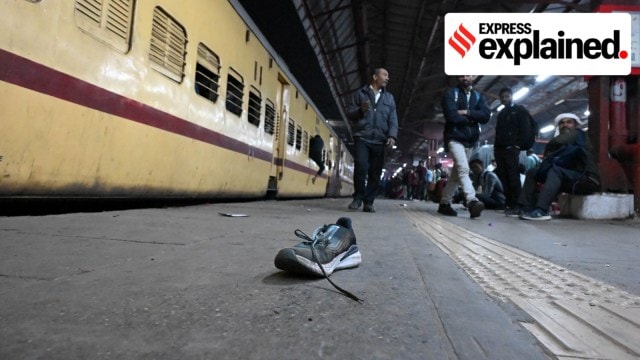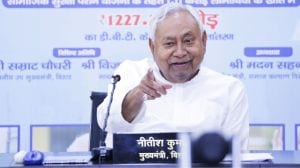New Delhi Railway Station stampede: Can government make ex-gratia payments to next of kin in cash?
The Ministry of Railways handed over wads of cash, in bundles of notes of Rs 100 and 50, after announcing that it would provide Rs 10 lakh ex-gratia to the kin of the 18 deceased in the stampede at the New Delhi Railway Station last week
 In the aftermath of the stampede on Saturday. (Express Photo by Gajendra Yadav)
In the aftermath of the stampede on Saturday. (Express Photo by Gajendra Yadav)The disbursal of ex-gratia compensation to the next of kin of those who died in the stampede at the New Delhi railway station last week has raised eyebrows, specifically with regards to the mode of payment.
The Ministry of Railways handed over wads of cash, in bundles of notes of Rs 100 and 50, after announcing that it would provide Rs 10 lakh ex-gratia to the kin of the 18 deceased in the incident. According to the next of kin who received the payment, the cash was handed over after the verification of their Aadhaar cards.
First, what is ex-gratia payment? How is it different from compensation?
Ex-gratia payments are payments made out of moral — not legal — obligation. For instance, ex-gratia payment by the government after a tragedy, such as the one which occurred in New Delhi last Saturday, shows its goodwill, and does not involve admitting any liability or wrongdoing.
Compensations, on the other hand, are made out of a legal obligation. They are reparatory payments made to reimburse or make amends for the loss of life, property, or livelihood, among other things.
How are ex-gratia payments made? Are cash payments common?
While disbursal of ex-gratia payment in cash is not common, there are no strict government-issued guidelines on the mode of such disbursals.
That said, in the case of train accidents, a 2023 communication by the Railway Board stipulated that a maximum amount of upto Rs. 50,000 is “to be paid in cash as an immediate relief for taking care of initial expenses” after rail accidents. “The remaining amount to be paid by Account Payee Cheque/RTGSNEFT/Any other online payment mode,” the communication stated.
A former government lawyer said, on condition of anonymity, that while cash payments of entire ex-gratia amounts are “not usual”, “the exigency has to be seen and if it requires immediate ex-gratia payment”. Generally most government departments prefer and recommend bank transfers of the full or at least a part of the amount?
But, are cash payments inconvenient for the recipient compared to a bank transfer?
Not necessarily.
As a former government lawyer noted, “that assuming a legal heir was handed over cash after confirming and due verification to establish heir-deceased relationship, the government will always have the record, given that it is being done through government offices and officials, and not at the behest of any individual or specific political party.”
However, a bank transfer “is concrete proof” and is always preferable over cash, “for better accountability and transparency”, several legal counsels concurred.
How has the cash ex-gratia payment been explained so far by the authorities?
The Ministry of Railways said that since ex-gratia payment is not the same as compensation, the cash handover is not contrary to its own 2023 instructions. Railway officials have also contended that cash disbursals are “not an unusual thing”, citing that the “ex-gratia was distributed in cash during the Balasore accident too.”
However, the 2023 communication clearly specifies the SOP for ex-gratia payments, not compensation.
“[Payment] is made in cash because the families usually do not have bank details in hand or some of the victims do not have bank accounts… The station master has the power to order the withdrawal of money [from the official account], which is then disbursed by the Commerce Department,” railways officials say.
How has the government dealt with ex-gratia payments in the past?
For ex-gratia payment to the next of kin of those who died during the Covid-19 pandemic, the Delhi government in January 2022, had issued detailed guidelines, listing the eligibility criteria, as well as grievance redressal committees for each of the 11 revenue districts.
The guidelines had categorically stated that the amount was to be disbursed through the “Aadhaar-linked Direct Benefit Transfer procedure”, and that claimants had to attach relevant documents in order to receive the payment. These included documents establishing the relationship between deceased and applicant, the Aadhaar card of the applicant, bank account-related documents, a surviving member certificate, and an NOC from other legal heirs other than the applicant.
A March 2020 order of the Delhi government’s relief branch under the Revenue Department had revised the scale of ex-gratia relief in case of various eventualities, including from fire, natural calamities, bomb blasts, communal riots, terrorist attacks etc. The order notes that the part of the ex-gratia amount “shall be given immediately”, without specifying the mode of payment, while the remaining part shall be disbursed “after the documentation process is completed and approvals obtained.”



- 01
- 02
- 03
- 04
- 05



































